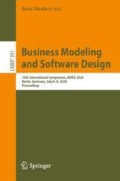Abstract
A complete information modeling method must address both the process- and data-perspectives, preferably in an integrated manner (i.e., also specifying which state change each process should achieve exactly). However, most approaches either emphasize only data or only processes. And when an approach handles both data and processes, there is usually no integration of processes and data. A language must have a precise semantics if tools are to perform intelligent operations on models expressed in the language. Moreover, formal semantics helps in detecting errors in and reasoning about specifications.
We give a precise, declarative, model-theoretic semantics for a large class of instruction languages that treats processes and data in an integrated manner. The instruction expressions are interpreted against a ‘state space’ (i.e., a set of ‘states’) and we consider the semantics of an instruction as the set of possible state transitions it can achieve. As a result, we can provide the integration of the different scenarios of a use case into one (textual) system sequence diagram with a well-defined semantics. We can also formally prove the semantic equivalence of several instructions, even for non-deterministic instructions.
The class of instruction languages provides a fruitful similarity between the structuring mechanisms for modeling business processes, textual system sequence diagrams, and programming languages, among others. This will ease the translation towards an implementation in a software system.
Access this chapter
Tax calculation will be finalised at checkout
Purchases are for personal use only
References
Olle, T.W., et al.: Information Systems Methodologies: A Framework for Understanding. Addison-Wesley, Boston (1991)
Övergaard, G., Palmkvist, K.: A formal approach to use cases and their relationships. In: Bézivin, J., Muller, P.-A. (eds.) UML 1998. LNCS, vol. 1618, pp. 406–418. Springer, Heidelberg (1999). https://doi.org/10.1007/978-3-540-48480-6_31
de Brock, E.O.: On system sequence descriptions. In: Proceedings NLP4RE (2020)
de Brock, E.O.: From business modelling to software design. In: Proceedings BMSD (2020)
http://www.bpmn.org/. Accessed 16 May 2020
http://www.orm.net/. Accessed 16 May 2020
https://archive.eiffel.com/doc/manuals/technology/bmarticles/uml/page.html. Accessed 16 May 2020
https://www.techwalla.com/articles/the-disadvantages-of-uml. Accessed 16 May 2020
https://www.omg.org/spec/UML/. Accessed 16 May 2020
Larman, C.: Applying UML and Patterns. Addison Wesley Professional, Boston (2005)
Stanford Encyclopedia of Philosophy, Stanford (in particular Compositionality and its Formal Statement). Accessed 16 May 2020
Goldblatt, R.I.: Logics of time and computation. CSLI Lecture Notes 7, Stanford (1992)
Montague, R.: Universal grammar. Theoria 36(3), 373–398 (1970)
Harel, D., Kozen, D., Tiuryn, J.: Dynamic Logic. MIT Press, Cambridge (2000)
Jacobson, I., et al.: Use Case 2.0: The Guide to Succeeding with Use Cases. Ivar Jacobson International (2011)
Cockburn, A.: Writing Effective Use Cases. Addison Wesley, Boston (2001)
Tiwari, S., Gupta, A.: A systematic literature review of use case specifications research. Inf. Softw. Technol. 67, 128–158 (2015)
Sinnig, D., et al.: LTS semantics for use case models. In: Proceedings of SAC, pp. 365–370 (2009)
Author information
Authors and Affiliations
Corresponding author
Editor information
Editors and Affiliations
Rights and permissions
Copyright information
© 2020 Springer Nature Switzerland AG
About this paper
Cite this paper
de Brock, B. (2020). Declarative Semantics of Actions and Instructions. In: Shishkov, B. (eds) Business Modeling and Software Design. BMSD 2020. Lecture Notes in Business Information Processing, vol 391. Springer, Cham. https://doi.org/10.1007/978-3-030-52306-0_20
Download citation
DOI: https://doi.org/10.1007/978-3-030-52306-0_20
Published:
Publisher Name: Springer, Cham
Print ISBN: 978-3-030-52305-3
Online ISBN: 978-3-030-52306-0
eBook Packages: Computer ScienceComputer Science (R0)

